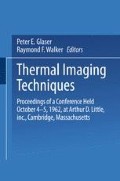Abstract
A few years ago, Arthur D. Little, Inc. designed and constructed a new type of carbon arc image furnace for Air Force Cambridge Research Laboratories (1,2). (Fig. 5–1). The axis of the furnace is vertical with an ADL-Strong blown carbon arc source mounted on top of the furnace. The thermal image of tnis source extends out of the double paraboloid mirror assembly and is accessible from below. This orientation is favorable for crystal growth and other applications. Because the carbon arc burns in air, the period of operation is limited due to consumption of the electrodes. Thus, only small crystal boules are possible. In addition, the negative electrode and air-scoop assembly produce a large illumination shadow resulting in irradiation losses. In order to fully exploit the clam-shell mirror arrangement, more appropriate sources were needed. Thus a further investigation into controllable, high-temperature sources was initiated.
Access this chapter
Tax calculation will be finalised at checkout
Purchases are for personal use only
Preview
Unable to display preview. Download preview PDF.
References
Arthur D. Little, Inc., “Development of the ‘Clam Shell’ Thermal Imager,” Final Report under Contract AF19(604)-6663.
Glaser, P.E., and Ploetz, G.P., “High-Temperature Generation and Control by Thermal Imaging Techniques,” Symposium on Temperature, Its Measurement and Control in Science and Industry, Columbus, Ohio, March 27–31, 1961.
Finkelnburg, W., “The High-Current Carbon Arc,” Fiat, Final Report 1052PB 81644 (U.S. Department of Commerce, Washington, D. C., 1947).
Maust, E.E., Jr., and Warnke, W. E., “The Performance and Operating Characteristics of an Image Furnace Having 60-in. Paraboloid Mirrors,” R1 5946, 1962, Bureau of Mines (U.S. Department of the Interior).
Richardson, D. L., “A Thermal Radiation Heat Source and Imaging System for Biomedical Research,” Final Report Contract N-62269-B88, March 31, 1962. (U.S. Naval Air Development Center, Johns ville, Pa.).
Ploetz, G. P., Cox, H. F., and Larsen, L.C., “The Carbon Vapor Lamp: A Thermal Radiation Source for Image Furnaces,” AFCRL 764, September 1961, Air Force Cambridge Research Laboratories, Bedford, Mass.
Author information
Authors and Affiliations
Editor information
Editors and Affiliations
Rights and permissions
Copyright information
© 1964 Springer Science+Business Media New York
About this paper
Cite this paper
Ploetz, G.P. (1964). The Carbon Vapor Lamp. In: Glaser, P.E., Walker, R.F. (eds) Thermal Imaging Techniques. Springer, Boston, MA. https://doi.org/10.1007/978-1-4899-5645-3_5
Download citation
DOI: https://doi.org/10.1007/978-1-4899-5645-3_5
Publisher Name: Springer, Boston, MA
Print ISBN: 978-1-4899-5647-7
Online ISBN: 978-1-4899-5645-3
eBook Packages: Springer Book Archive

